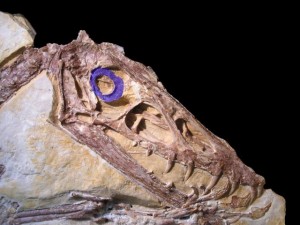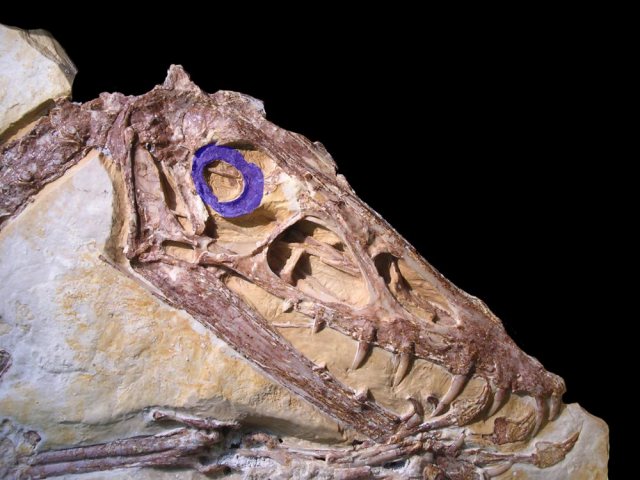恐竜の頭蓋骨研究から、少なくともいくつかの種類の恐竜では、夜間に行動ができる視力をもっていたようです。
Nocturnal dinosaurs
R. Motani, L. Schmitz, Phylogenetic versus functional signals in the evolution of form-function relationships in terrestrial vision. Evolution, published online 14 April 2011 (10.1111/j.1558-5646.2011.01271)
We make several important points in these papers: (i) Dinosaurs were not restricted to day-activity (diurnality) by any means, (ii) Activity patterns evolve following ecological characteristics (e.g., diet+body size, terrestrial or flying), (iii) Physics of the environment drive the evolution of shape, (iv) We have a great new tool for reconstructing ecology of extinct species.
上記は論文著者の一人、L. Schmitzさんのサイトから。もう一人の著者は
藻谷亮介さんです。
強膜輪っていう、眼を支える骨があるんですね。哺乳類にはないけど、鳥類などにはある。

この大きさを、現生の動物で調査し、夜行性と昼間動く動物では形態に違いがあることが分かったそうです。そこで、それを恐竜にあてはめたところ、たとえばヴェロキラプトルは夜行性と考えられると。
映画『ジュラシック・パーク』には恐竜たちが夜間にハンティングするシーンが出てきますが、演出上だけではなく、それはあながち嘘じゃなかったと。一方で、哺乳類は恐竜を逃れて夜間に行動したため、視覚はあまり発達させなかったという話がありましたが、さて、こうなってくると、夜も結構危なかったようです。
恐竜のセンシング能力については、先日、
初期の鳥には匂いも重要だったという記事も紹介しました。ある意味、ホットな研究分野なのでしょうか。
論文は下記。
Nocturnality in Dinosaurs Inferred from Scleral Ring and Orbit Morphology
Variation in daily activity patterns facilitates temporal partitioning of habitat and resources among species. Knowledge of temporal niche partitioning in paleobiological systems has been limited by the difficulty of obtaining reliable information about activity patterns from fossils. On the basis of an analysis of scleral ring and orbit morphology in 33 archosaurs, including dinosaurs and pterosaurs, we show that the eyes of Mesozoic archosaurs were adapted to all major types of diel activity (that is, nocturnal, diurnal, and cathemeral) and provide concrete evidence of temporal niche partitioning in the Mesozoic. Similar to extant amniotes, flyers were predominantly diurnal; terrestrial predators, at least partially, nocturnal; and large herbivores, cathemeral. These similarities suggest that ecology drives the evolution of diel activity patterns.
 この大きさを、現生の動物で調査し、夜行性と昼間動く動物では形態に違いがあることが分かったそうです。そこで、それを恐竜にあてはめたところ、たとえばヴェロキラプトルは夜行性と考えられると。
映画『ジュラシック・パーク』には恐竜たちが夜間にハンティングするシーンが出てきますが、演出上だけではなく、それはあながち嘘じゃなかったと。一方で、哺乳類は恐竜を逃れて夜間に行動したため、視覚はあまり発達させなかったという話がありましたが、さて、こうなってくると、夜も結構危なかったようです。
恐竜のセンシング能力については、先日、初期の鳥には匂いも重要だったという記事も紹介しました。ある意味、ホットな研究分野なのでしょうか。
論文は下記。
この大きさを、現生の動物で調査し、夜行性と昼間動く動物では形態に違いがあることが分かったそうです。そこで、それを恐竜にあてはめたところ、たとえばヴェロキラプトルは夜行性と考えられると。
映画『ジュラシック・パーク』には恐竜たちが夜間にハンティングするシーンが出てきますが、演出上だけではなく、それはあながち嘘じゃなかったと。一方で、哺乳類は恐竜を逃れて夜間に行動したため、視覚はあまり発達させなかったという話がありましたが、さて、こうなってくると、夜も結構危なかったようです。
恐竜のセンシング能力については、先日、初期の鳥には匂いも重要だったという記事も紹介しました。ある意味、ホットな研究分野なのでしょうか。
論文は下記。



